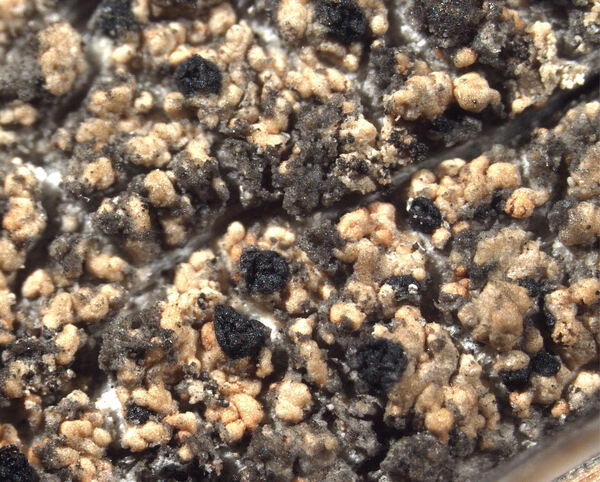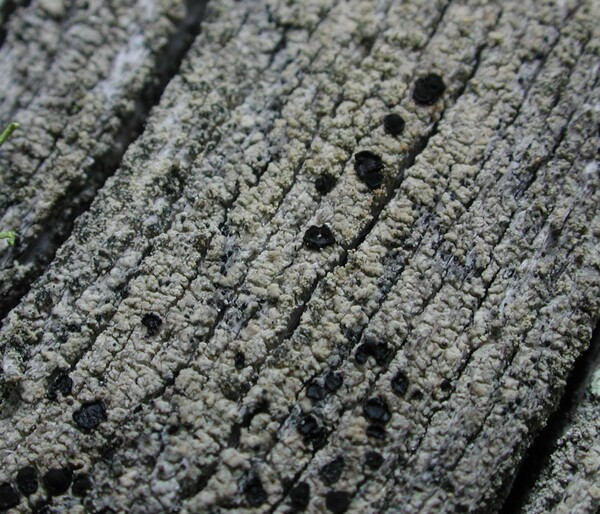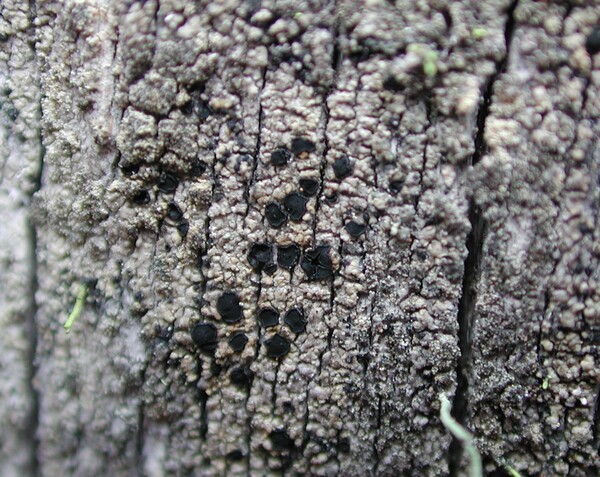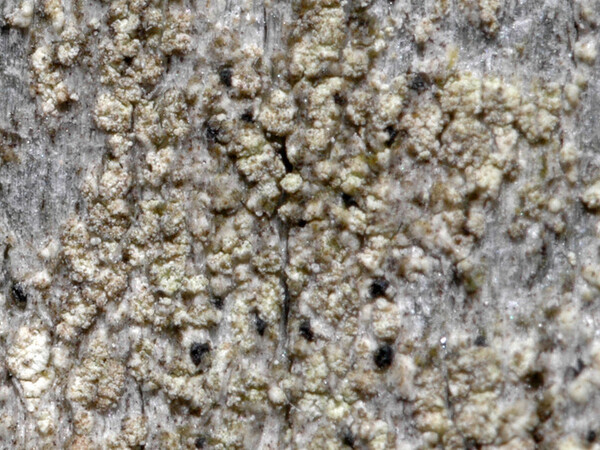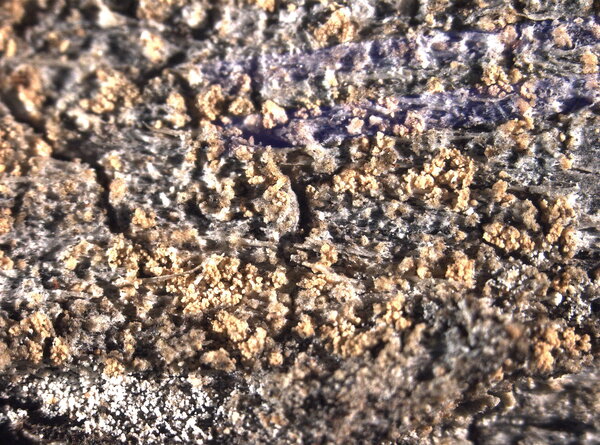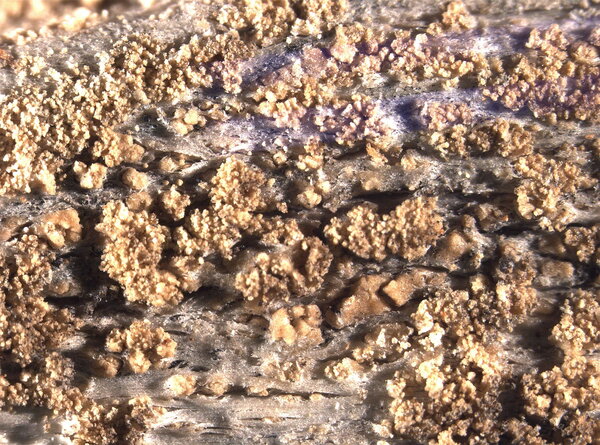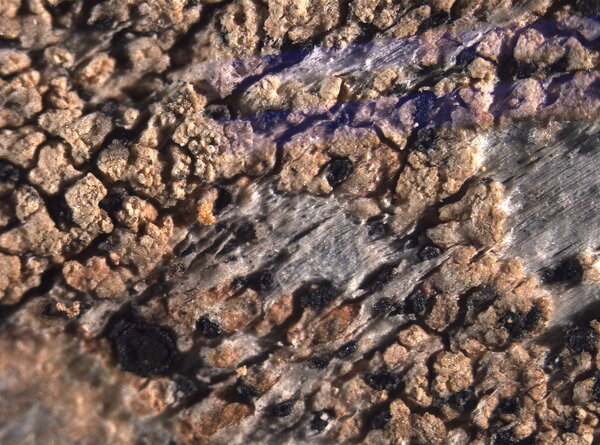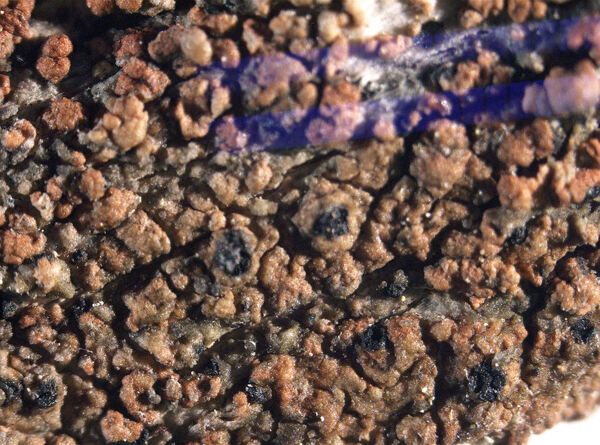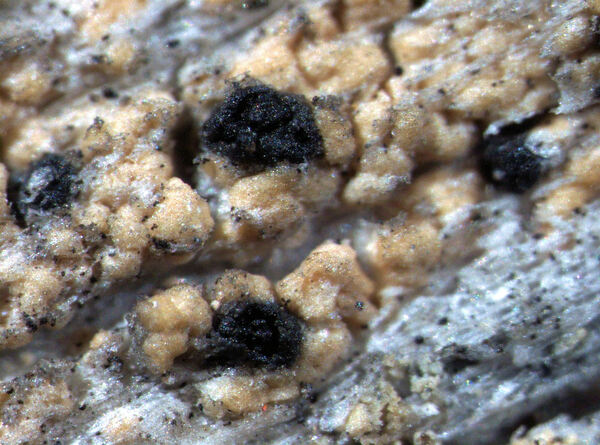Pycnora sorophora (Vain.) Hafellner
in Poelt & Vezda, Bibl. Lichenol., 16: 364, 1981. Basionym: Lecidea xanthococca subsp. sorophora Vain. - Acta Soc. Fauna Fl. Fenn., 57, 2: 237, 1834.
Synonyms: Hypocenomyce sorophora (Vain.) P. James & Poelt; Lecidea giselae Zahlbr.
Description: Thallus crustose, endo- to episubstratic, areolate, the areoles pale grey to yellowish brown, dull, up to 0.5(-1) mm wide, adnate, weakly convex; soredia bursting from apices or from margins of the areoles, yellowish brown, diffuse, farinose. Cortex up to 15 µm thick, of thin-walled hyphae. Apothecia rare, lecideine, up to 0.6 (-0.8) mm across, with a black, flat to weakly convex, epruinose, egyrose disc and a prominent, entire or slightly flexuose proper margin. Proper exciple of closely conglutinated hyphae, black in outer part, brown within, K+ violet, N-; epithecium green to greenish brown, not containing crystals, K+ violet, N+ violet; hymenium colourless, 55-70 µm high; paraphyses sparingly branched and anastomosing, the apical cells hardly swollen; hypothecium brown. Asci 8-spored, broadly clavate, with a well developed, amyloid tholus containing an ocular chamber and a broad axial mass, Lecanora-type. Ascospores 1-celled, hyaline, broadly to narrowly ellipsoid, 6-9 x 2.5-4.5 µm. Pycnidia sessile, black, up to 0.22 mm across, with a dirty green wall reacting K-, N+ violet. Conidia ellipsoid to shortly bacilliform, 3.5-5 x 1.5-2.7 µm. Spot tests: K+ brownish yellow, C+ red, KC+ red, P+ yellow, UV-. Chemistry: alectorialic acid and an unknown substance.
Growth form: Crustose
Photobiont: green algae other than Trentepohlia
Reproductive strategy: mainly asexual, by soredia, or soredia-like structures (e.g. blastidia)
Commonnes-rarity: (info)
Alpine belt: absent
Subalpine belt: very rare
Montane belt: extremely rare
Dry submediterranean belt: absent
Humid submediterranean belt: absent
Padanian area: absent
pH of the substrata:
1 2 3 4 5
Solar irradiation:
1 2 3 4 5
Aridity:
1 2 3 4 5
Eutrophication:
1 2 3 4 5
Poleotolerance:
0 1 2 3
Altitudinal distribution:
1 2 3 4 5 6
Rarity
absent
extremely rare
very rare
rare
rather rare
rather common
common
very common
extremely common
Loading data...
Occurrence data
Predictive map
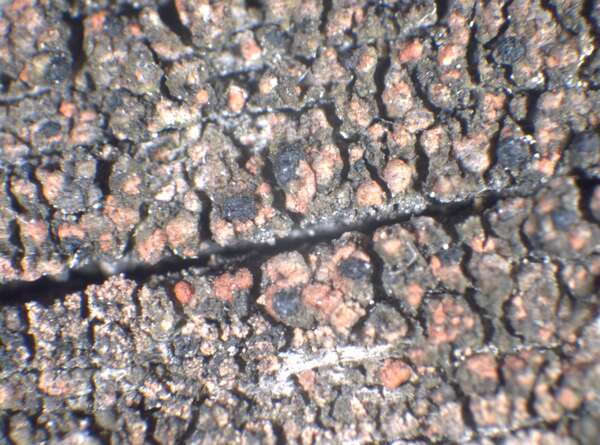
P.L. Nimis; Owner: Department of Life Sciences, University of Trieste
Herbarium: TSB (14773)
2002/05/17
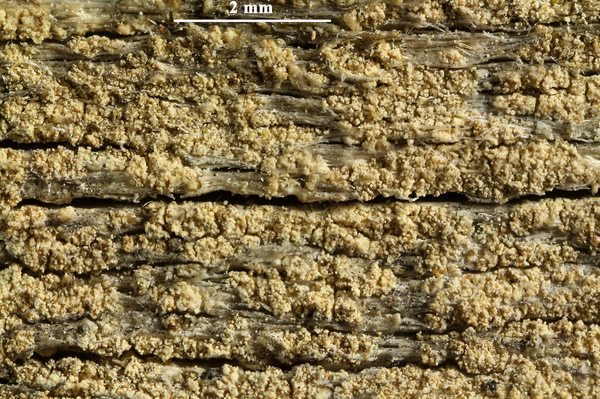
Felix Schumm - CC BY-SA4.0
[20897], Austria, Oberösterreich, Gneiss and Granite Plateau, Innvirtel, Schärding district, St. Ägidi, Flenkental 8, farmstead
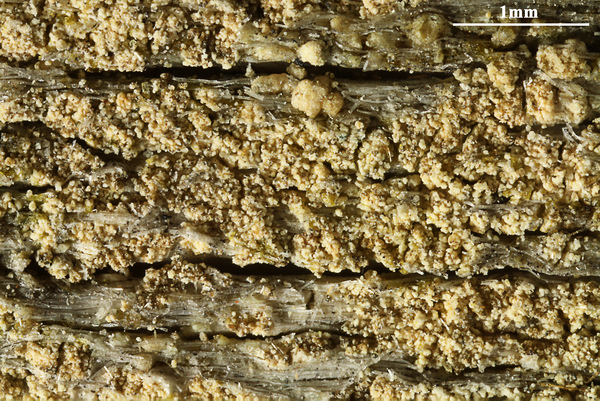
Felix Schumm - CC BY-SA4.0
[20897], Austria, Oberösterreich, Gneiss and Granite Plateau, Innvirtel, Schärding district, St. Ägidi, Flenkental 8, farmstead "Stuhlberger", 48°30'01'' N, 13°43'10'' E, 560 m, on spruce boards of an old barn. Leg. F. Berger (no 30916), 4.6.2016, det. F. Berger. TLC: alectorialic acid (maj), barbatolic acid (?), anal. by Obermayer 557/15. LICHENOTHECA GRAECENSIS NR. 473.
Growth form: Crustose
Photobiont: green algae other than Trentepohlia
Reproductive strategy: mainly asexual, by soredia, or soredia-like structures (e.g. blastidia)
Commonnes-rarity: (info)
Alpine belt: absent
Subalpine belt: very rare
Montane belt: extremely rare
Dry submediterranean belt: absent
Humid submediterranean belt: absent
Padanian area: absent
pH of the substrata:
| 1 | 2 | 3 | 4 | 5 |
Solar irradiation:
| 1 | 2 | 3 | 4 | 5 |
Aridity:
| 1 | 2 | 3 | 4 | 5 |
Eutrophication:
| 1 | 2 | 3 | 4 | 5 |
Poleotolerance:
| 0 | 1 | 2 | 3 |
Altitudinal distribution:
| 1 | 2 | 3 | 4 | 5 | 6 |
Rarity
absent
extremely rare
very rare
rare
rather rare
rather common
common
very common
extremely common
Loading data...
Occurrence data
Predictive map

P.L. Nimis; Owner: Department of Life Sciences, University of Trieste
Herbarium: TSB (14773)
2002/05/17

Felix Schumm - CC BY-SA4.0
[20897], Austria, Oberösterreich, Gneiss and Granite Plateau, Innvirtel, Schärding district, St. Ägidi, Flenkental 8, farmstead



